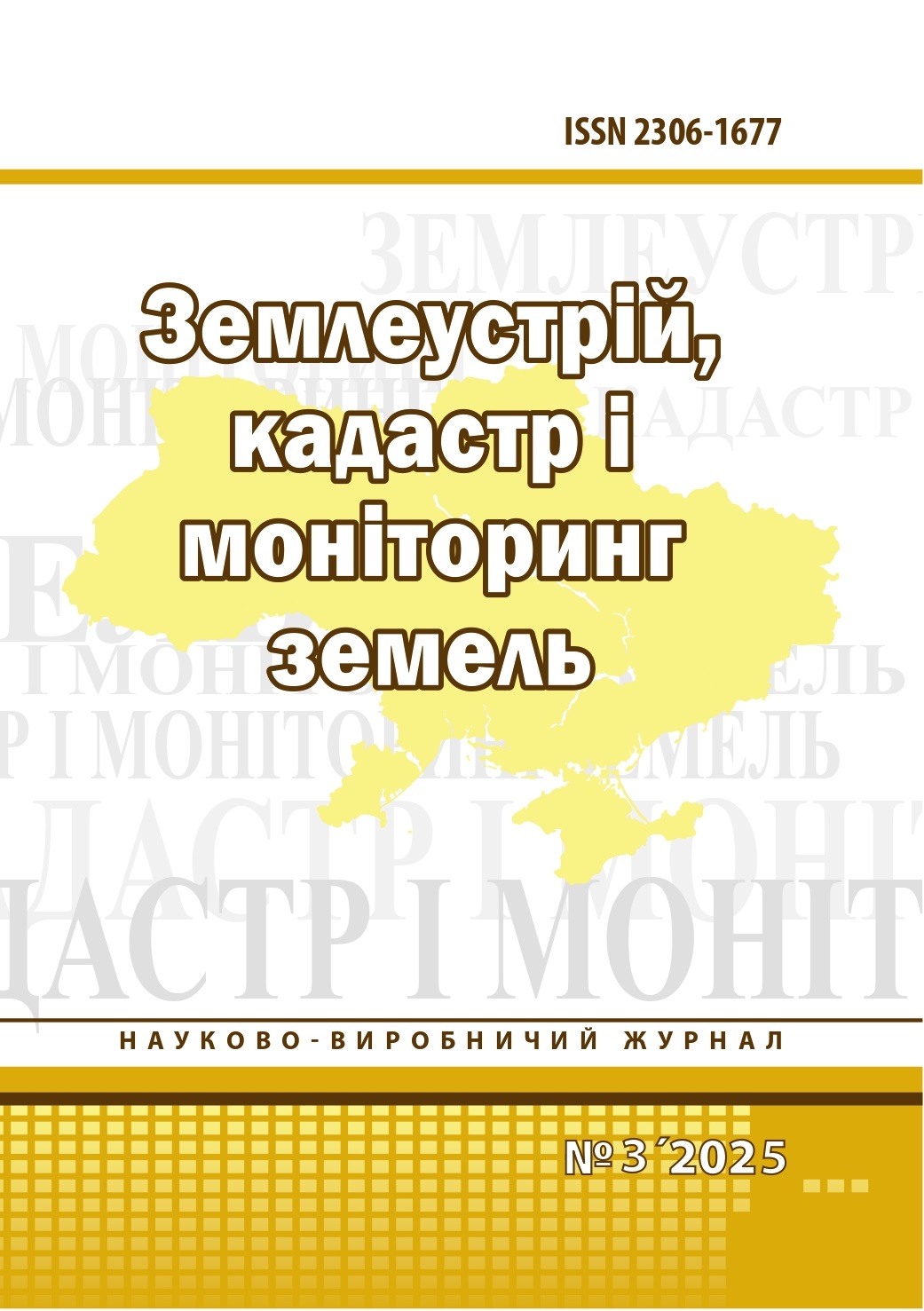Розроблення концептуальної моделі бази геопросторових даних небезпечних поховань тварин, які загинули від сибірки
DOI:
https://doi.org/10.31548/zemleustriy2025.03.05Ключові слова:
база геопросторових даних, концептуальна модель, сибіркаАнотація
В статті представлено авторський підхід до систематизації і накопичення геопросторових та атрибутивних даних щодо небезпечних поховань тварин, які загинули від сибірки. Сибірка є зоонозним захворюванням, спори якого здатні зберігати життєздатність у ґрунті протягом десятків років і залишатись джерелом потенційної загрози. Поховання тварин, здійснені не у біотермічних ямах (головним чином до 1954 року), не забезпечують належного рівня безпеки: у разі зміщення ґрунтового покриву спори можуть потрапити на поверхню і стати причиною нових випадків захворювання серед диких і свійських тварин, а також інфікування людей. Значна частина таких поховань не має чітко встановлених меж земельних ділянок і встановлених режимів обмеженого використання прилеглих територій, що ускладнює контроль за їхнім станом.
У межах дослідження було структуровано наявні геопросторові та атрибутивні дані про небезпечні поховання і розроблено концептуальну модель бази геопросторових даних, що забезпечує накопичення, структурування й систематизацію даних. Модель побудована з використанням нотації UML та представлена у вигляді діаграми класів, що відображає головні структурні елементи бази даних та їхні атрибути.
Отримані результати можуть бути використані для створення фізичної моделі бази геопросторових даних з обліку (реєстру) земель з небезпечними похованнями тварин, що загинули від сибірки, а також для подальшого розвитку системи моніторингу, планування санітарно-захисних заходів, встановлення режимів обмеженого землекористування та ін.
Ключові слова: база геопросторових даних, концептуальна модель, сибірка.
Посилання
1. Rublenko, I. O., Skrypnyk, V. G., Machusky, O. V. (2015). Udoskonalennya metodyky vydilennya spor sybirky iz gruntu bakteriolohichnym metodom [Improving the technique for isolating anthrax spores from soil by bacteriological method]. Scientific Bulletin of Veterinary Medicine, 2, 107-112. Available at: http://nbuv.gov.ua/UJRN/nvvm_2015_2_21.
2. Bondarenko, A. M. (2024). Sybirka yak biolohichna zbroya: mozhlyvosti zastosuvannya pid chas viyny [Anthrax as a Biological Weapon: Possibilities of Application During War]. Infectious Diseases, (2), 63–71. doi: 10.11603/1681-2727.2024.2.14614
3. Shapoval, V.F., Pivovar, S.M., Rudenko, L.M., Matsiychuk, P.V. (2022.07.28). Profilaktyka sybirky – vse, shcho potribno znaty [Anthrax prevention - everything you need to know]. Available at: https://globin.pmsd.net.ua/novyny/profilaktyka-sybirky/
4. European Commission. ADIS - Outbreaks weekly map overview. Received 29.09.2025 p from Animal disease information system (ADIS). Available at: https://webgate.ec.europa.eu/tracesnt/adis/public/notification/outbreaks-weekly-report
5. Moskalenko, A., Ievsiukov, T. (2025). Development of a Geospatial Database Model for Registration and Monitoring of Detected Cases of a Dangerous Anthrax Disease. Proceding of the Conference «Synergy in Terra». Lviv (Ukraine), 1-3. Available at: https://drive.google.com/file/d/1iIFBgU6vsQsulMkc-2wLTm3REJ4nlLCL/view
6. European Parliament and Council of the European Union. Regulation (EU) 2016/429 of the European Parliament and of the Council of 9 March 2016 on transmissible animal diseases and amending and repealing certain acts in the area of animal health (Animal Health Law). Official Journal of the European Union. Available at: https://eur-lex.europa.eu/legal-content/EN/TXT/?uri=CELEX%3A32016R0429
7. Yanenko, U. M., Kos’yanchuk N. I. Nebezpeka vynyknennya sybirsʹkoyi yazvy na nekontrolʹovanykh terytoriyakh Ukrayiny [The danger of anthrax outbreak in uncontrolled territories of Ukraine]. World Science, 23, 530-533. Available at: http://nbuv.gov.ua/UJRN/vbtb_2013_23_80.
8. Makovs'ka, I.F., Bezymennyj, M.V., Nedosjekov, V.V., Kornijenko, L.Je., Carenko, T.M., Mel'nyk, V.V., Martynjuk, O.G., Zhukovs'kyj, M.O. (2020) Geoinformacijnyj analiz poshyrennja skazu u Vinnyc'kij oblasti [Geoinformation analysis of the spread of rabies in Vinnytsia region ] Scientific Bulletin of Veterinary, 2, 39–49. doi: 10.33245/2310-4902-2020-160-2-39-49
9. Otieno, F. T., Gaehohi, J., Gikuma-Njuru, P., Kariuki, P., Oyas, H., Canfield, S. A., ... Bett, B. (2021). Modeling the spatial distribution of anthrax in southern Kenya. PLOS Neglected Tropical Diseases, 15(3), e0009301. doi: 10.1371/journal.pntd.0009301
10. Learnmore, J., Shekede, M. D., Gwitira, I., Mazhindu, A. N., Pfukenyi, D. M., Chikerema, S. (2024). Modelling climate change impacts on the spatial distribution of anthrax in Zimbabwe. BMC Public Health, 24, A. 632. doi: 10.1186/s12889-024-1
11. Lyashchenko, A. A., Zakharchenko, E. A. (2019). Kontseptualʹne modelyuvannya ta pryntsypy realizatsiyi bazy heoprostorovykh danykh kadastru pryrodnykh likuvalʹnykh resursiv [Conceptual modeling and principles of implementation of the geospatial database of the cadastre of natural medicinal resources]. Scientific notes of the Volodymyr Hnatyuk Ternopil National Pedagogical University. Series: Geography, (1), 233-240. doi: 10.25128/2519-4577.19.2.29
12. Lyashenko, D. O., Koper, N. E. (2023). Kontseptualʹne modelyuvannya dlya zavdanʹ heoinformatsiynoho zabezpechennya ekolohichnoho turyzmu [Conceptual modeling for geoinformation support tasks of ecological tourism]. Ukrainian Geographical Journal, 1, 67-73. doi: 10.15407/ugz2023.01.067
13. Ievsiukov, T., Moskelanko, A. (2025). Kontseptualʹna modelʹ heoinformatsiynoho modelyuvannya vplyvu nebezpechnykh pokhovanʹ tvaryn, yaki zahynuly vid sybirky, na prylehli terytoriyi [Conceptual model of geoinformation modeling of the impact of dangerous burials of animals that died from anthrax on adjacent territories]. Proceedings of the International Conference “Land Unity Summit 2025”. Ivano-Frankivsk (Ukraine), 100-103.
14. VetSpace. Map of registered cases of Anthrax in Ukraine. Available at: https://www.anthrax.vet.ua/index.php/anthrax-in-ukraine#47.8027482/30.7212424/7/cats/11/hotspot/8
15. European Commission (2025). Animal disease information. Available at: https://webgate.ec.europa.eu/tracesnt/adis/public/notification
Завантаження
Опубліковано
Номер
Розділ
Ліцензія
Авторське право (c) 2025 Землеустрій, кадастр і моніторинг земель

TЦя робота ліцензується відповідно до ліцензії Creative Commons Attribution-ShareAlike 4.0 International License.
Стосунки між правовласниками і користувачами регулюються на умовах ліцензії Creative Commons Із Зазначенням Авторства – Некомерційна – Поширення На Тих Самих Умовах 4.0 Міжнародна (CC BY-NC-SA 4.0):https://creativecommons.org/licenses/by-nc-sa/4.0/deed.uk
Автори, які публікуються у цьому журналі, погоджуються з наступними умовами:
- Автори залишають за собою право на авторство своєї роботи та передають журналу право першої публікації цієї роботи на умовах ліцензії Creative Commons Attribution License, котра дозволяє іншим особам вільно розповсюджувати опубліковану роботу з обов'язковим посиланням на авторів оригінальної роботи та першу публікацію роботи у цьому журналі.
- Автори мають право укладати самостійні додаткові угоди щодо неексклюзивного розповсюдження роботи у тому вигляді, в якому вона була опублікована цим журналом (наприклад, розміщувати роботу в електронному сховищі установи або публікувати у складі монографії), за умови збереження посилання на першу публікацію роботи у цьому журналі.
- Політика журналу дозволяє і заохочує розміщення авторами в мережі Інтернет (наприклад, у сховищах установ або на особистих веб-сайтах) рукопису роботи, як до подання цього рукопису до редакції, так і під час його редакційного опрацювання, оскільки це сприяє виникненню продуктивної наукової дискусії та позитивно позначається на оперативності та динаміці цитування опублікованої роботи (див.The Effect of Open Access).


